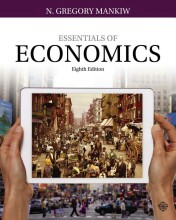Summary: Essentials Of Economics | 9781337091992 | N Gregory Mankiw
- This + 400k other summaries
- A unique study and practice tool
- Never study anything twice again
- Get the grades you hope for
- 100% sure, 100% understanding
Read the summary and the most important questions on Essentials of Economics | 9781337091992 | N. Gregory Mankiw
-
1 Introduction
-
1.2.1 The economist as scientist
This is a preview. There are 12 more flashcards available for chapter 1.2.1
Show more cards here -
How do scientists (like economists) develop a scientific method?
By observing reality, devising a theory, and observing more, in order to verify/dispute the theory. -
What is the purpose of assumptions, and why do economists make assumptions when trying to understand economic problems?
- To simplify the complex world and make the problem easier to understand.
- To focus on the essence of the problem. -
What is the purpose of economic models, and why are they used by economists?
Economic modelssimplify reality . Economists use economic models tolearn about the world. -
What is the Circular-Flow Diagram, and what is its purpose?
- Aschematic representation of the economy, that explains how the economy isorganized .
- Shows how households and firms interact with each other. -
Which are the inputs, necessary to produce something (the factors of production)?
1.Land (natural resources)
2.L abour
3.C apital (tools)
4.E ntrepreneurship -
Why is applying the scientific method particularly challenging in economics (unlike in other sciences)?
Because conducting economical experiments is oftenimpractical : the data is mostly given and notderived from self performed experiments.
Ex: a nation'smonetary policy cannot be changed simply togenerate useful data. -
What is the role of firms, in the Circular Flow Diagram?
-Firms produce/sell goods and services for revenue, on the "markets for goods and services".
-Firms use/hire factors of production, for wages, rent and profit on the "markets of factors ofproduction ". -
What is the role of households, in the circular flow diagram?
-Households spend money to buy/consume goods and services on the 'markets for goods and services'.
-Households own/sell thefactors of production for income on 'the markets forfactors of production'. -
What useful data do economists use, in order to find a subsitute for laboratory experiments?
Economists look at history (n aturally occurring experiments). Historical episodescan be valuable to evaluate present economic theories. -
What is the Production Possibilities Frontier?
Agraph that shows variouscombinations ofoutput that the economy canpossibly produce (given the available factors of production/technology).
- Higher grades + faster learning
- Never study anything twice
- 100% sure, 100% understanding
Topics related to Summary: Essentials Of Economics
-
Introduction - Thinking like an economist - The economist as scientist
-
Introduction - Thinking like an economist - The economist as a policy adviser
-
Introduction - Thinking like an economist - Why economists disagree
-
Introduction - Thinking like an economist - Graphing
-
Introduction - Interdependence and the gains from trade - A parable for the modern economy
-
Introduction - Interdependence and the gains from trade - Comparative advantage: the driving force of specialization
-
How markets work - The market forces of supply and demand - Markets and competition
-
How markets work - The market forces of supply and demand - Demand
-
How markets work - The market forces of supply and demand - Supply
-
How markets work - The market forces of supply and demand - Supply and demand together
-
How markets work - Elasticity and its application - The elasticity of demand
































